#About #PWYM
If someone says “online course” you might think about a very passive experience, like watching lectures, talking multiple choice quizzes, or reading out of an e-book. At P2PU we focus on passion, play and projects, and we were seeing less “play” in the exercises and tutorials in the online education landscape. We wanted to change the conversation, to encourage creative expression and nurture originality. We believed we could offer a learning experience that would include mastering new skills, certainly, but do so as a byproduct of creative projects.
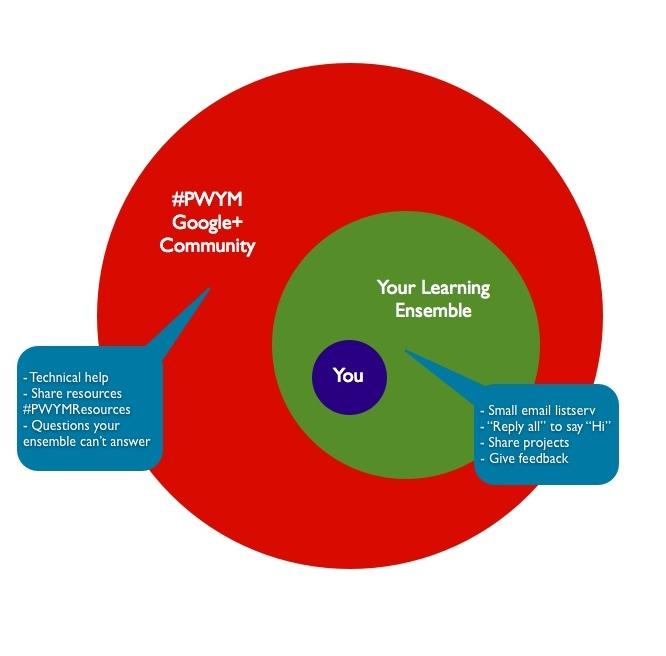
Play With Your Music is about learning music while playing with music. It’s a hands-on introduction to the creative processes of audio engineers and producers. The first six-week course provided an introduction to critical listening, strategies for learning from recordings, musical uses of audio effects, mixing and remixing. In November 2013, over 5, 000 participants signed up to participate. They worked together in small “Learning Ensembles” of 30-40 people to make their own mixes and remixes, and shared their sounds along the way via SoundCloud.com.
From the outset, the #PWYM team–Dr. Alex Ruthmann (NYU), Ethan Hein (NYU), Vanessa Gennarelli (P2PU) and Dirk Uys (P2PU)– approached the course as a design-based research project. We were interested in ways to build a sense of “belonging” to a community in an online space. Our hypothesis was that small groups with shared musical interests or tastes would sustain engagement, support peer learning, and prompt deeper feedback. We wanted folks to feel like they had a “crew” they could depend on.
We wanted to develop not just a great learning experience, but a design-driven research project to grow knowledge around peer-driven learning online. In this paper we reflect on the aims, the experience, and the lessons learned from PWYM.
Fast Facts
-
A big crew: 5,232 folks signed up, we formed 132 cohorts of 30-40 learners each
-
1,743 active members in the PWYM G+ community, 24 cohorts formed their own groups on G+
-
Say cheese! 1,533 members uploaded photos to their class photo
-
Making music, together. The #PWYM SoundCloud group had nearly 30,000 listens, 1,500 favorites, and 550 downloads and 500 comments
#Design Principles and Tools
When we look back at it now, the fact that only four weeks elapsed between our kickoff meeting and opening for signups seems insane. In four short weeks we built a website, developed promotional materials, wrote a grouping script, designed the learning content and activities, shot and edited videos, recruited and scheduled guest speakers, drafted the assessment program, tested the tools, and reached out to music communities around the web.
It helps if you have a common mission. #PWYM shared some common design principles that we kept in mind as we built each aspect of the course:

-
#PWYM would be about lifelong learning for the widest possible audience.
This content would be accessible, targeted at beginners, and playful. This meant designing experiences around free, browser-based creative tools that fostered sharing, collaboration and peer feedback. We also partnered with singer/songwriter Clara Berry and her engineer/producer Bradford Swanson to provide musical multitracks as interactive course content that PWYM participants could work with. -
Design for low floors and high ceilings.
We would make sure there were easy ways to get started and lots of possibilities to take projects further. We curated some of the best pre-existing online instructional videos, and created introductory videos modeling use of the the course’s creative tools to lower the floor of entry. To engage the more experienced learners, we designed open-ended analysis templates and encouraged all participants to share their expertise through peer-feedback and contributions to the course resources. -
Empower learners with choices.
If they want to use Google+ or another musical engineering program–great! Each week of the course, participants were encouraged to apply the tools to their own favorite music (analysis) or creative mixes and remixes of course material. Participants were encouraged to create their own original piece to be shared the last week of the course on SoundCloud.com and the Google+ group. Finally, all course content emails were posted to the PWYM blog so stragglers or outsiders could follow along at their own pace. -
Model a reflective practice.
Both the weekly instructional videos and live interview questions were focused on sharing one’s creative thinking and practice processes, with a special focus on the musical, expressive, and creative intentions behind their work. A reflective sharing component was built into each week’s assignments with the directive to share one’s creative works and reflections with the broader Google+ community. -
Design for social presence. Give learners the feeling that they are interacting with real people, not just a pseudonym. Create opportunities for folks to cohere and share personal stuff from their lives. The live interviews also enabled a “real” connection and opportunities through group chat to ask questions.

With these design principles in mind, we utilized the following structures and tools:
-
Mechanical MOOC: A grouping script to form small cohorts of learners to communicate via email.
-
Google+: umbrella for the whole #PWYM community, used to post resources, questions, projects and feedback.
-
Soundation.com: a digital audio workstation to help folks learn the basics of mixing and remixing.
-
SoundCloud.com: an online repository for #PWYM folks to post their masterpieces.
-
Unhangout: a forum for videoconference-style Q&A with our weekly guest speakers.
-
Badges: a means for learners to assess their skills and receive feedback.
-
Weekly newsletters: a way to showcase exemplary projects and take a wide-angle lens on the developments in the community.
-
GIFs. Lots of GIFs.
#Learning Ensembles
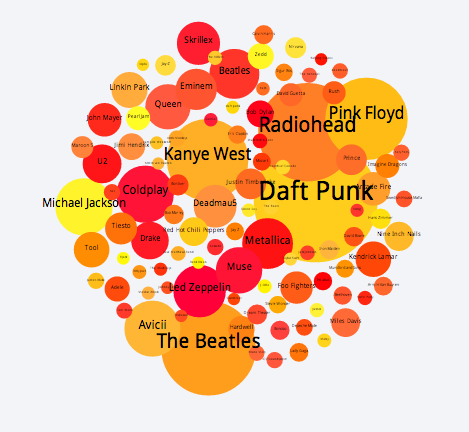
Thinkers in the learning landscape are interested in developing a sense of “belonging to a learning community” as a means to motivate learners. This is certainly a big area of interest for P2PU, and is reflected in many of our design principles for PWYM. If you feel as though you fit in a group and deserve to be there, you’ll feel positively about learning, not shy away from challenges, and reach out to others to help buoy you up when you need help. A sense of belonging can help overcome certain roadblocks for learners. Folks who feel like they don’t belong can display poor learning behaviors. They might not ask questions if they feel out of place, not wanting to draw attention to their outsider status. In the open online learning environment these challenges are particularly relevant, given we are often dealing with learners with no prior ties to one another, varying degrees of preparedness, and the ability to drop off at any time with little accountability for their absence.
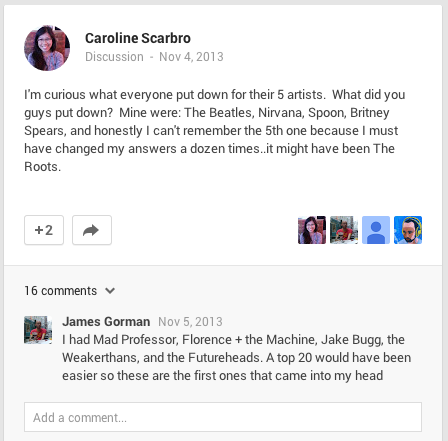
For #PWYM, we decided to create cohorts of 30-40 folks, grouped based on their musical taste, to create learning communities to which learners could feel they belonged. When learners came to www.playwithyourmusic.org to sign up, they were asked what their top 5 musical artists were. From that data, we used the Echonest API to form “learning ensembles” with overlapping and similar taste. A nice side-effect of using a tool like Echonest is the ability to collect data and visualize the communities we create (providing another avenue of engagement for learners). Here’s a visual of #PWYM musical tastes at a high level.
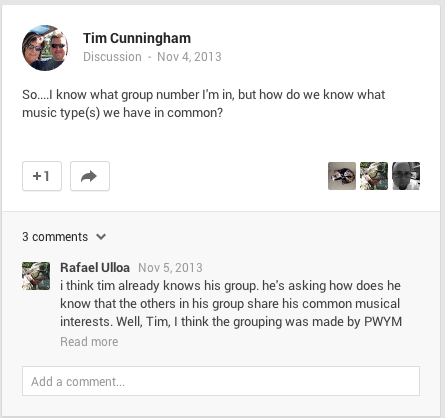
This proved successful as a means of initial engagement: when the groups were announced, learners tried to “reverse engineer” the algorithm we’d developed – clearly grouping based on musical taste had piqued the interest of our community.
Interested in how we implemented the Echonest API? Find our snappy documentation here: How We Used the Echonest API for Engagement and Learning
We think about these “learning ensembles” as affinity groups, as a means for groups to build a culture that they might belong to.
In fact several groups went ahead and branded themselves. Check out the varied identities cohorts took on to form their own cultures:
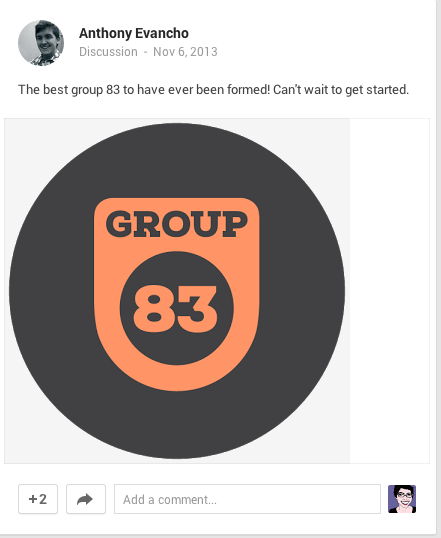
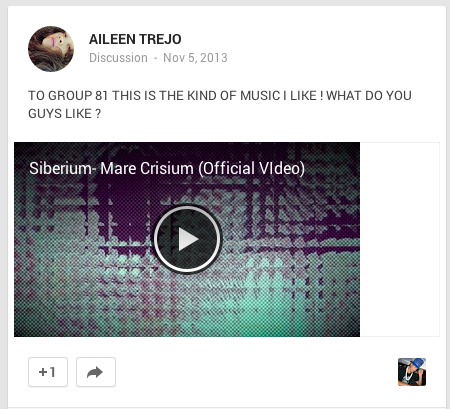
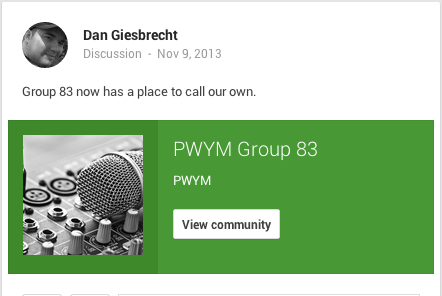
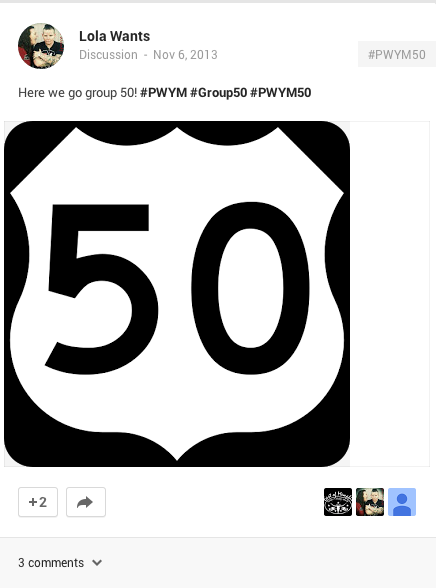
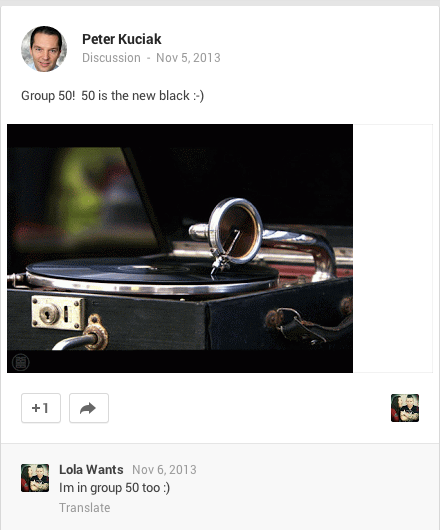
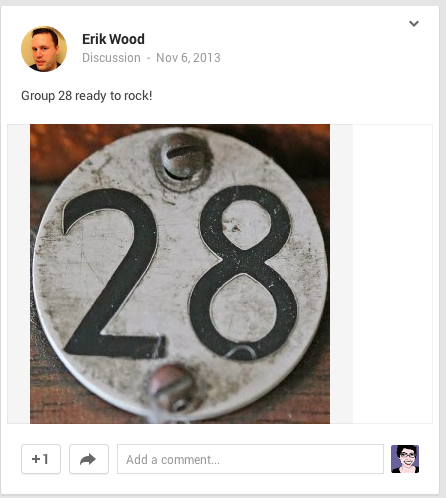
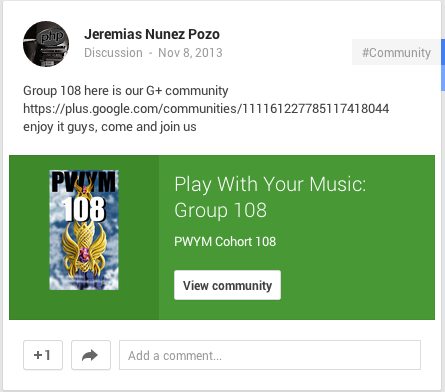
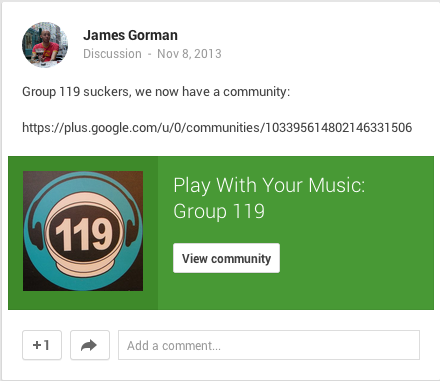
#Findings
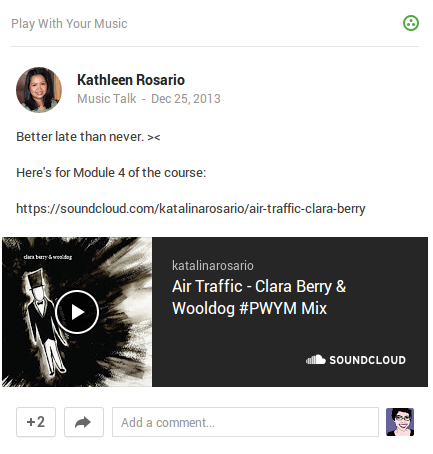
As previously mentioned, we thought of #PWYM as a design-based research project. Throughout the course, the PWYM team met virtually to discuss feedback from participants, making adjustments to content and course structure along the way. As the course wound down we began to crunch our datasets, including:
-
Email engagement within groups: number of times emails were opened, links clicked, replies to the group
-
Comments in the G+ community
-
Clicks on YouTube videos
-
Post-course survey (110 responses - 2% response rate as compared to sign-ups; 6.7% as compared to G+ group enrollment)
We started out with the hypotheses that our small cohorts would lead to sustained engagement. If our small groups enable learners to take risks and share, then their colleagues would buoy them up and help combat attrition (completion rates for traditional MOOCs hover around 7%). But as the course round down in week six, several surprising things happened.

Stragglers still learn.
What was surprising to us was that folks continued to post projects several weeks after the “deadlines” had passed. In the comments, folks mentioned that they had watched previous learners post their projects, and were inspired by them. Others apologized for the late post, like these folks who posted their projects a full 2 months later.
Learners found their own crew.
We noticed an interesting trend about halfway through the course. If a learner found that their cohort wasn’t active (or active enough) they would post their project to the wider #PWYM G+ community. From there, learners began to self-form into their own groups, often with folks who were at the same point in the learning material.
Participation is a continuum.
While a lot has been said about MOOC retention, we found that when we drilled down and got more granular, folks participated at different levels, in different ways, in different parts of the course. While many learners accessed the core content, others gave feedback, posted their own projects, or commented on the G+ site. Participation isn’t “on” or “off”–there are many points of entry and engagement.
How important are credentials?
We didn’t offer certificates of completion for this course, but we did feature 4 #PWYM Badges for folks to submit their projects. Of the 5,000+ folks who signed up and the relatively active 1, 500 folks in the G+ community, less than 50 learners applied for Badges. Researchers at EdX have found that most learners who took their courses were not interested in the assessments, and that certification is a “poor proxy for learning” in MOOCs (Ho 2014). Since this course was aimed at an informal audience, it’s possible learners did not prioritize the credentials, but instead valued the audience they gained on the G+ community and on SoundCloud.
Expertise matters.
While P2PU courses empower learners to create their own content, the input of experts matters as well. The weekly live interviews from industry experts empowered learners to engage directly with experts and received high praise from the community.
“The live interviews were amazing.”
“I did not expect so many quality guest speakers.”
“Very good course material (I’m particularly grateful to Alex Case). Also, I didn’t expect Brad Swanson to do a Soundation mix himself and explain his process in details. You made this mechanical MOOC very humane, with lots of input. And the whole approach of learning to listen before mixing was very helpful. Thank you very much.”
The course that doesn’t end.
In addition to our steady stream of stragglers, our post-course survey revealed that learners planned to keep going. Some learners liked specific tools, some were inspired to move their creative endeavors in a new direction, some wanted to try more advanced mixing programs. To wit:
“I learned more than I anticipated and prompted me to pursue additional online learning avenues such as Lynda.com”
“Lots of good pointers. Clearly explained instructions. Fun assignments. Love the SoundCloud and am going to contribute more in there.”
“My wife composes a lot of music, and I’m interested in producing a lot of that mixing synths and live instruments to make recordings of some of those compositions.”
“I would love to produce audio tracks to support video production work for my employer. These would be things like public service announcements (I work for the San Diego County District Attorney) and “feel good” videos about the work we do in the community. I’d also like to continue improving my ability to produce my own recorded tracks (singer and guitarist).”
Expectations are high.
The first P2PU courses were run on wikis—the open education landscape has changed a lot since then, and learners’ expectations for free courses are higher. Immediately after course launched, we found a bug that gummed up our ability to send emails from the Mechanical MOOC. Even though we had messaged our course as experimental, and frequently posted tech support updates, the learners were restless. Unfortunately this bug may have contributed to attrition early on in the course. Lesson here: troubleshoot, brand your experience as an “Alpha” and have a direct way for learners to file bug reports.
Google+ please give us your data.
We loved using Google+. Many learners already had profiles, and they would receive timely notifications from the #PWYM community. However, Google doesn’t currently have an API for G+, so we were unable to access this engagement data. We’d love to see Google enable Community Statistics for non-profits moving forward. Please, Google?
#Discussion
This was P2PU’s first foray into the “creative expression” space, and we learned a lot from it. Additionally our findings and experiences have implications for the wider MOOC and online learning landscape. As the EdX folks have noted, MOOCs are a different beast, and the definition of “student” or a “course” might need to be rethought in this context. We agree, and put another few terms up for discussion.
Retention.
As we could see from the stragglers and ongoing G+ activity, #PWYM’s momentum didn’t stop after the course officially “ended.” Latecomers paid attention to what the initial learners posted, took inspiration from them, and continued to work on projects in their own time. In this light, retention is longitudinal. Or put another way, courses are a way to introduce new people to a wider, ongoing community. Courses don’t need to stop, nor should they—mentors can help newbies who are struggling in the first weeks of the course.
Assessment. We’ve discussed at length how we think assessment should work like the web, but #PWYM added another dimension to the discussion. After we grouped cohorts together, learners sought expertise and camaraderie outside their small group. In a social learning environment, finding “your people” is a way of successfully navigating the community. We suggest that finding your “crew” or your cohort is a kind of assessment. Knowing who has the expertise you are looking for is as important as having the right question.
Cohorts.
As we mentioned, we were really excited by the idea of building affinity groups when we grouped folks by musical taste. Our hope was that, by building small communities, we would help groups develop a feeling of belonging. However, that engagement, for most groups, was short-lived. Small groups may have grounded folks in the #PWYM community initially, but they needed a reason to build and own their culture. In the future, we suggest designing a balance of structure and serendipity in an online learning community. We’ll also be paying attention to when learners begin to use the language “we” and “our.” And six weeks might not be enough time for a group to gel.
Community.
Thinking through how to bootstrap, nurture, and maintain a community is vital in a MOOC. We’re really proud of the feedback we received about the #PWYM community:
“I wasn’t sure what I would really learn, but this course offered great material, in a great format, with the aid of a fantastic community.”
“I was amazed how helpful the PWYM community was to each other.”
“i met different people of different cultures and musical tastes but had 1 thing in common… .music and production didn’t really know what to expect in the first place”
We seeded our community pages with sample content, modeled a reflective practice, and encouraged people to share their sounds with others. Especially in an online context, learning is inherently social. We advise future MOOCs to consider how the community will interact as their first design principle.
We’re really pleased with the outcome of the course. If success in open learning is building a vibrant community of practice, with learners who will continue to imagine new ways to deploy the skills they’ve learned, then we’ve achieved it. We’re also excited about our results and their ramifications for online learning in the future–project-based, creative, but above all rooted in community.
What’s Next for #PWYM?
PWYM 2.0 is a nifty collaboration with renowned rock star Peter Gabriel. Many of the core projects and experiences will be the same, however, we will be focusing on creative music and audio production skills using the music of Peter Gabriel. In addition to assisting you in analyzing and making your own music, we’ll augment the class with interviews from musicians who’ve performed and collaborated with Peter in the past. So we believe experienced PWYM participants will have a chance to make new connections and go deeper–and help others along the way. #PWYM 2.0 begins May 16, 2014. Sign up here: playwithyourmusic.org.
Citations
Ho, A. D., Reich, J., Nesterko, S., Seaton, D. T., Mullaney, T., Waldo, J., & Chuang, I. (2014). HarvardX and MITx: The first year of open online courses (HarvardX and MITx Working Paper No. 1).